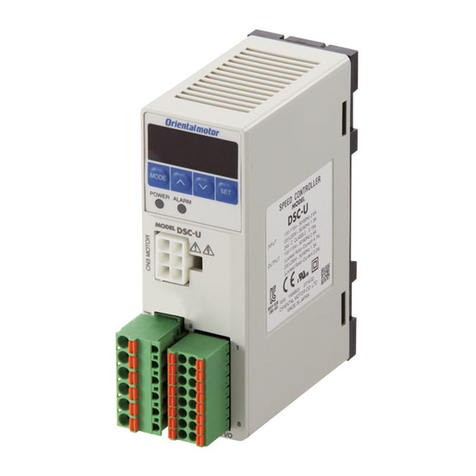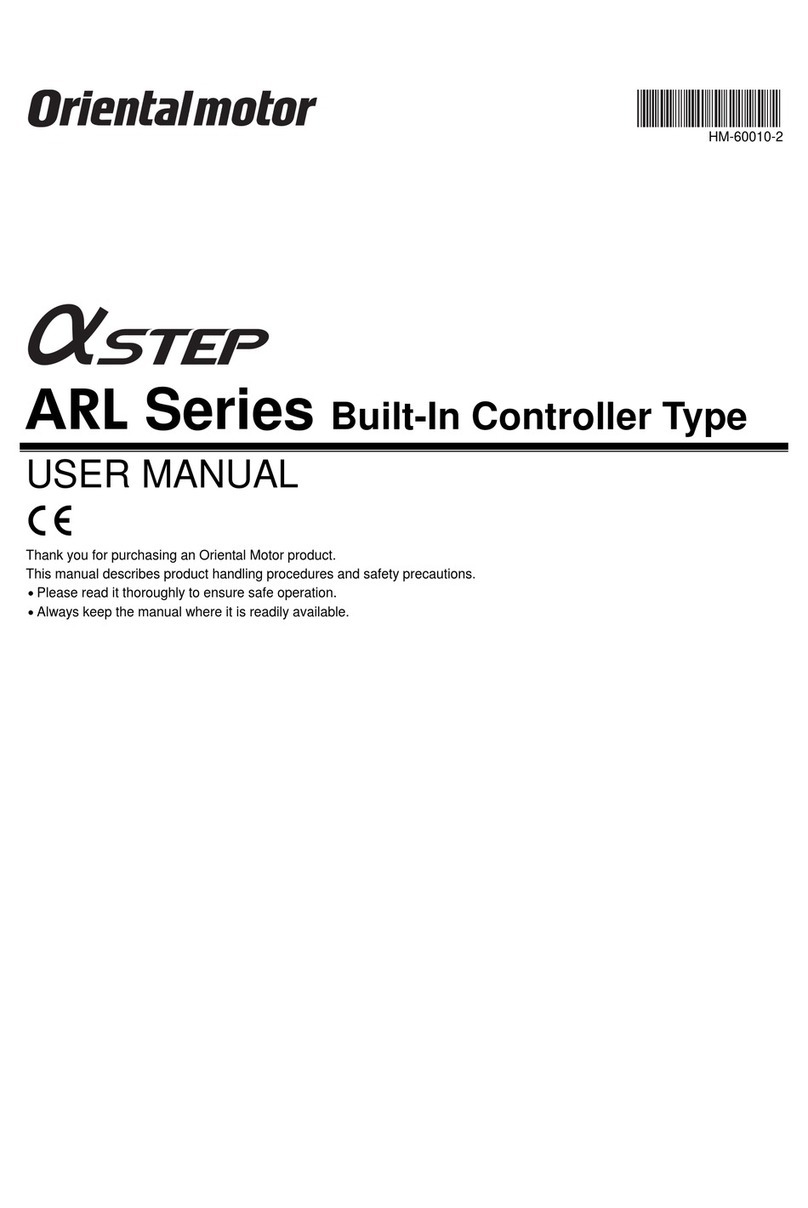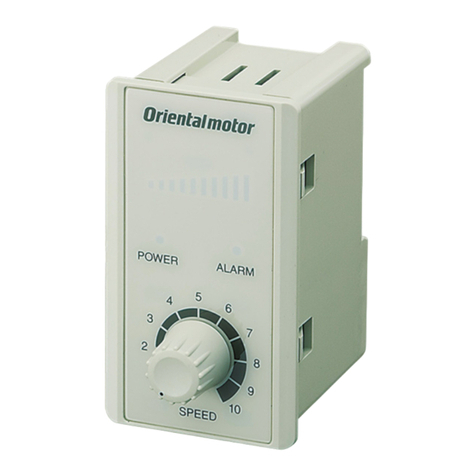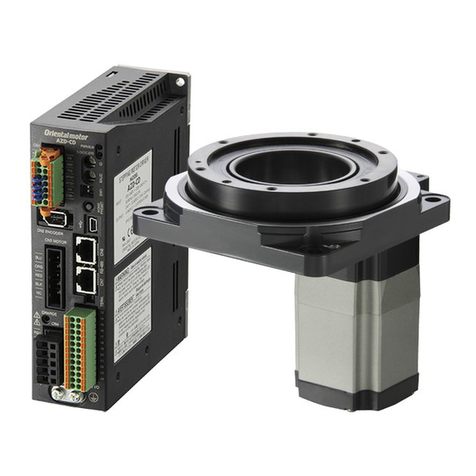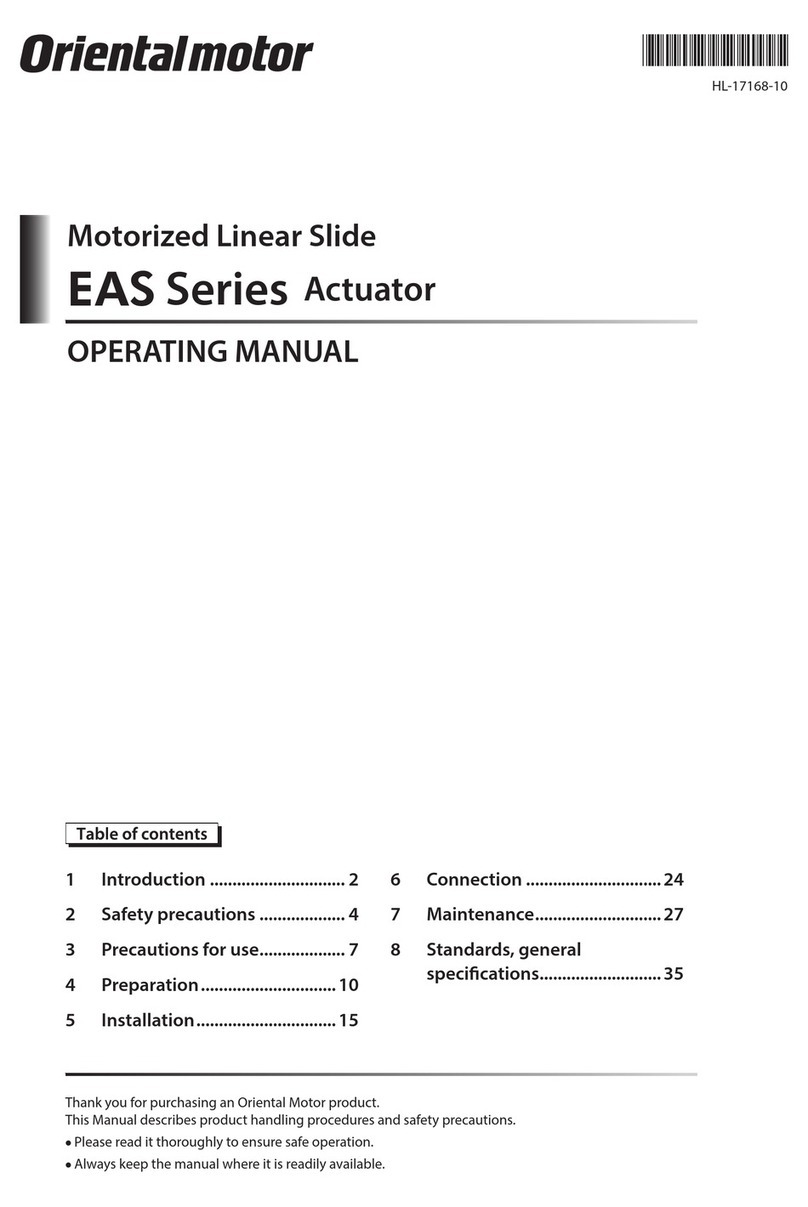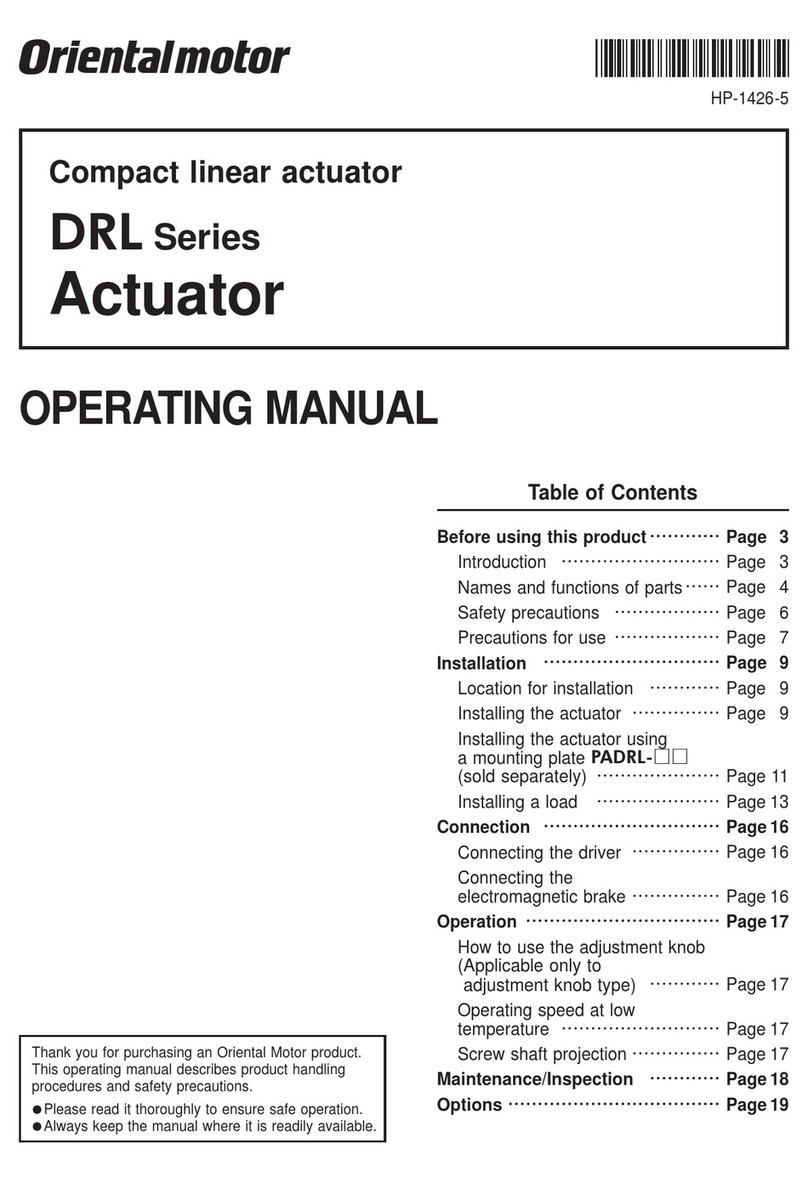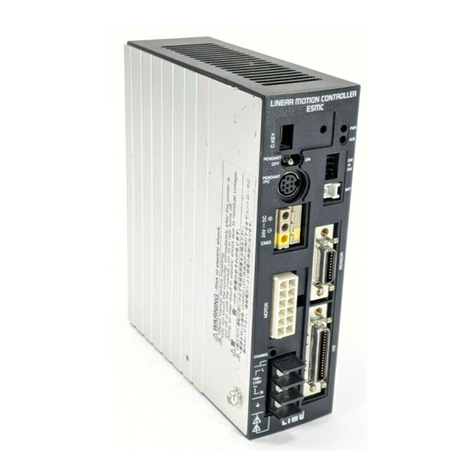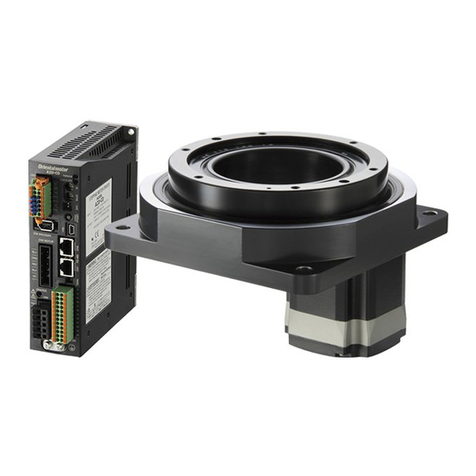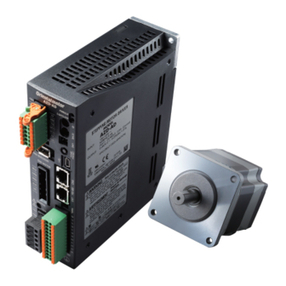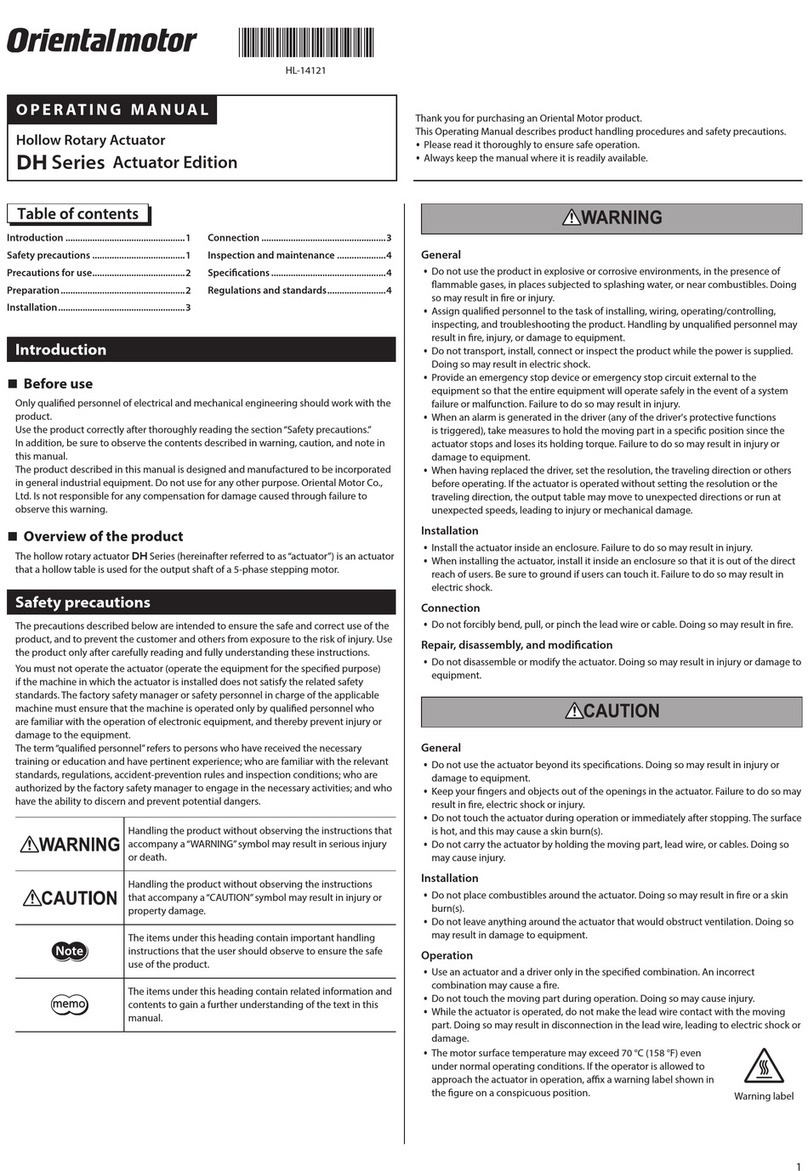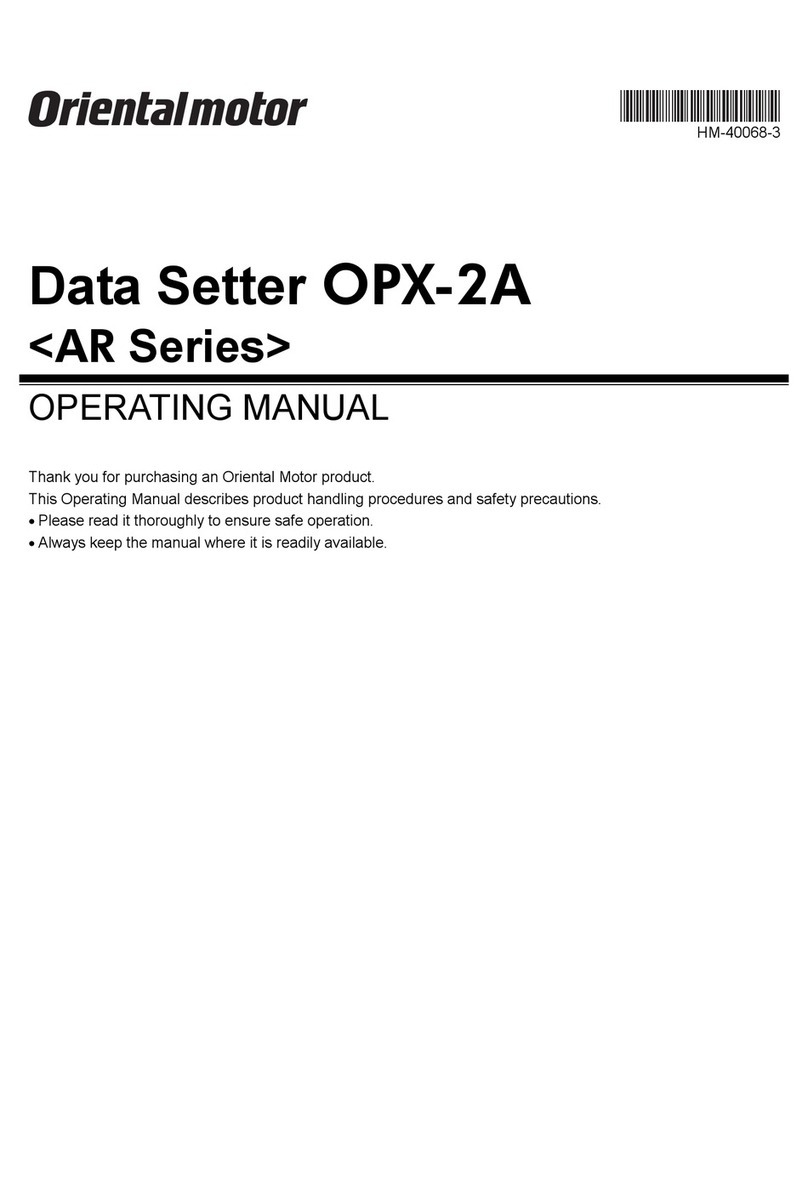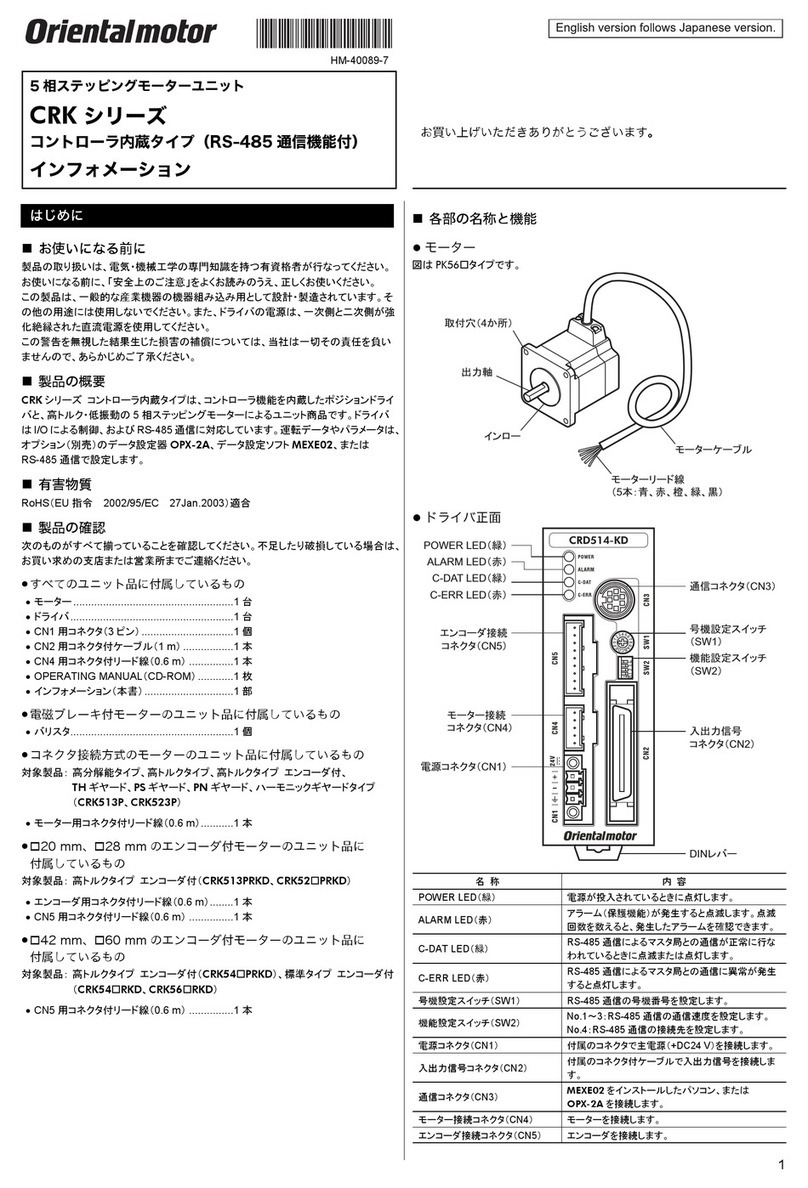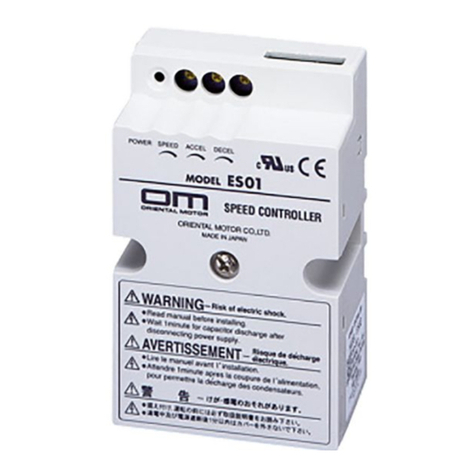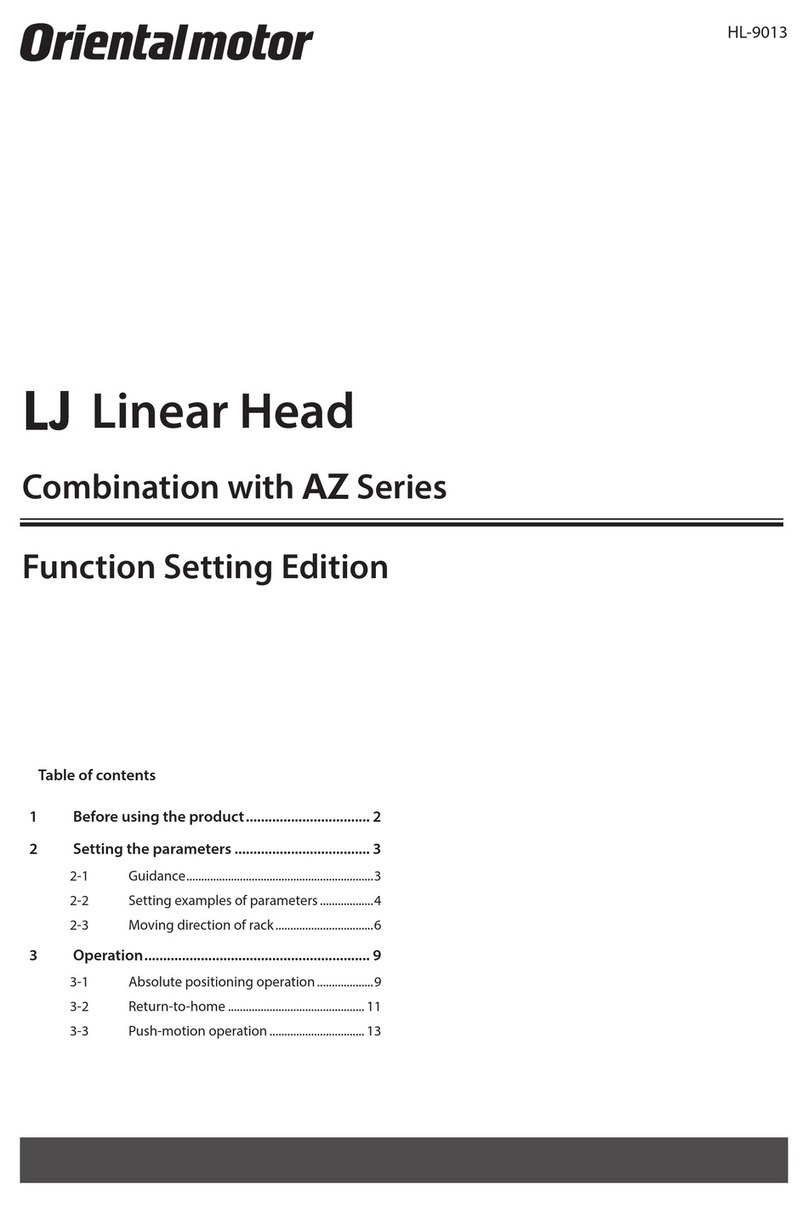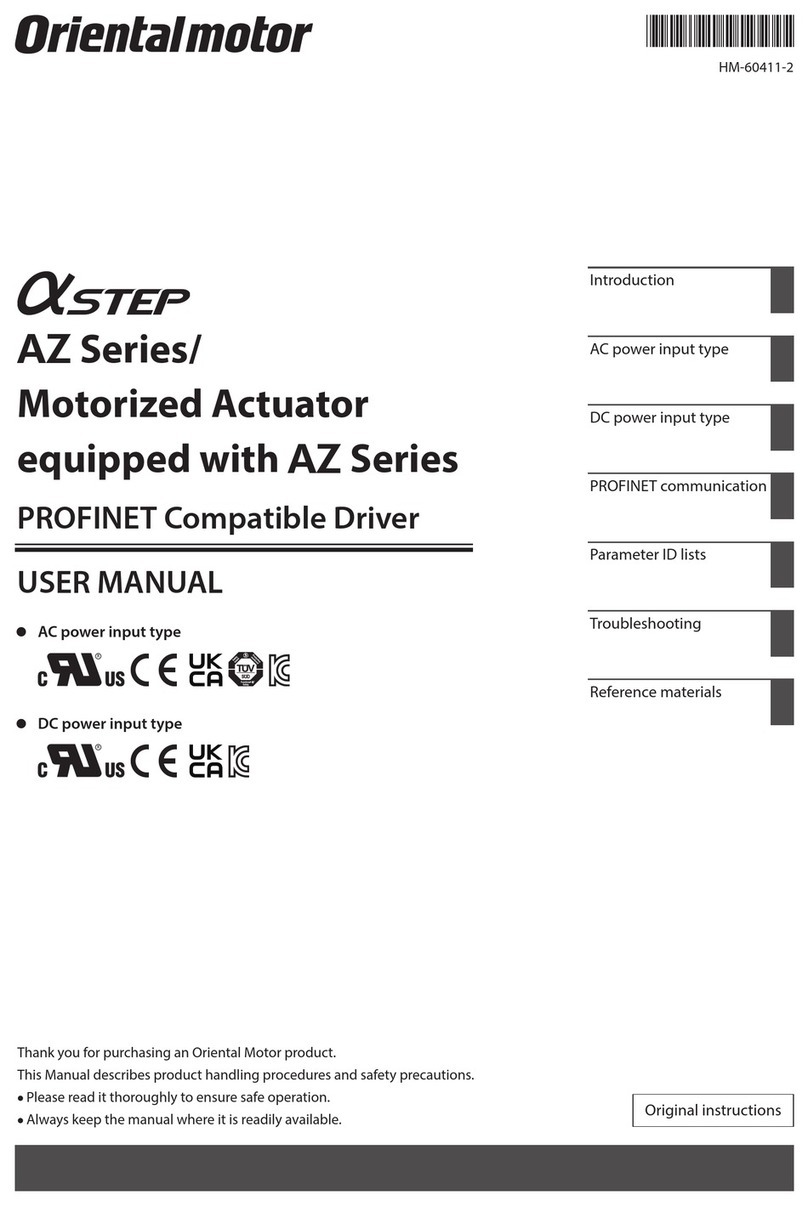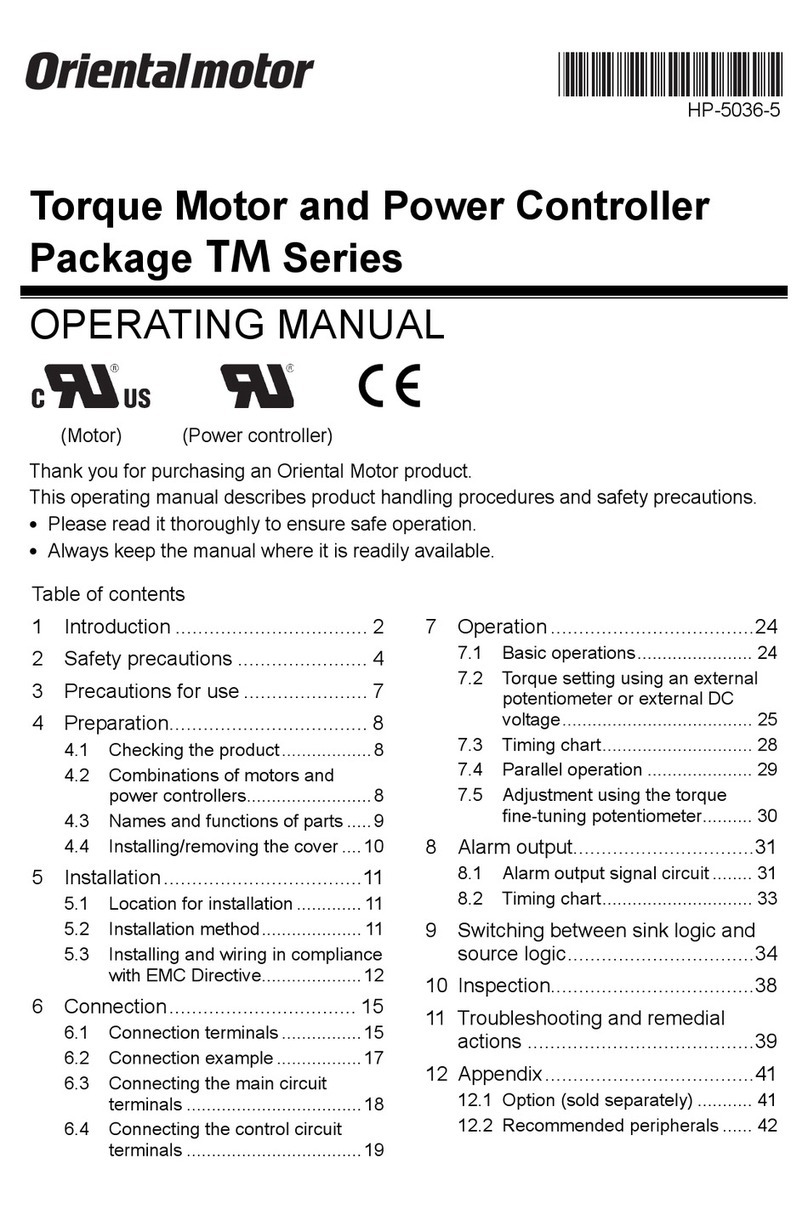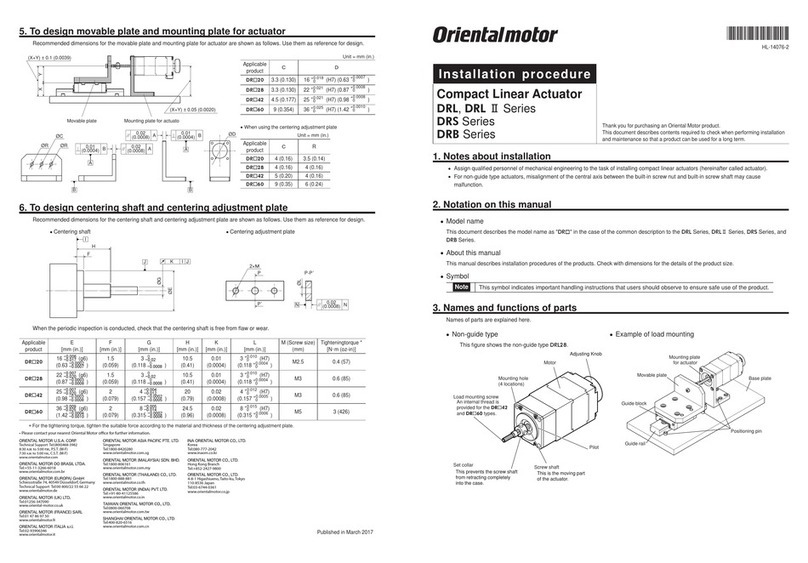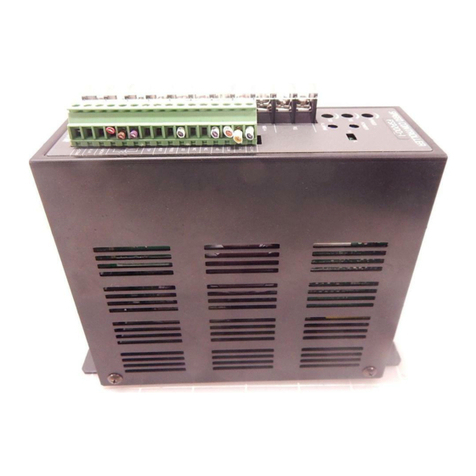
4
yUnauthorized reproduction or copying of all or part of this manual is prohibited.
yOriental Motor shall not be liable whatsoever for any problems relating to industrial
property rights arising from use of any information, circuit, equipment or device
provided or referenced in this manual.
yCharacteristics, specications and dimensions are subject to change without notice.
yWhile we make every eort to oer accurate information in the manual, we welcome
your input. Should you nd unclear descriptions, errors or omissions, please contact the
nearest oce.
yand are registered trademark or trademark of Oriental Motor
Co., Ltd., in Japan and other countries.
© Copyright ORIENTAL MOTOR CO., LTD. 2012
Published in February 2018
echnical Support Tel:(800)468-3982
A.M. to 5:00 P.M., P.S.T. (M-F)
A.M. to 5:00 P.M., C.S.T. (M-F)
.orientalmotor.com
Schiessstraße 44, 40549 Düsseldor
f, Germany
echnical Support Tel:00 800/22 55 66 22
.orientalmotor.de
el:01256-347090
.oriental-motor.co.uk
el:01 47 86 97 50
.orientalmotor.fr
el:02-93906346
.orientalmotor.it
el:+55-11-3266-6018
.orientalmotor.com.br
• Please contact your nearest Oriental Motor oce for further information.
4-8-1Higashiueno
,Taito-ku,Tokyo 110-8536
el:03-6744-0361
.orientalmotor.co.jp
Tel:0800-060708
www.orientalmotor.com.tw
Singapore
Tel:1800-8420280
www.orientalmotor.com.sg
Tel:1800-806161
www.orientalmotor.com.my
Korea
Tel:080-777-2042
www.inaom.co.kr
Tel:1800-888-881
www.orientalmotor.co.th
Tel:400-820-6516
www.orientalmotor.com.cn
Tel:+91-80-41125586
www.orientalmotor.co.in
Hong Kong Branch
Safety precautions
The precautions described below are intended to prevent danger or injury to the user
and other personnel through safe, correct use of the product. Use the product only after
carefully reading and fully understanding these instructions.
Handling the product without observing the instructions that accompany a“Warning”
symbol may result in serious injury or death.
General
yDo not use the product in explosive or corrosive environments, in the presence of
ammable gases, locations subjected to splashing water, or near combustibles. Doing
so may result in re or injury.
yAssign qualied personnel the task of installing, wiring, operating/controlling,
inspecting and troubleshooting the product. Failure to do so may result in re, injury
or damage to equipment.
yThe actuator will lose its holding torque when its excitation or the power supply is
turned o. Take measures to keep the moving part in position if the product is used
in vertical operations such as elevator applications. Failure to provide such measures
may cause the moving parts to fall, resulting in injury or damage to equipment.
yDo not use the brake mechanism of the actuator with an electromagnetic brake for
stopping or for safety purposes. The electromagnetic brake is used for the purpose to
hold the moving part and actuator in position. Failure to do so may result in injury or
damage to equipment.
yWith certain types of alarms (protective functions), the actuator may stop when the
alarm generates and the holding torque will be lost as a result. This may result in injury
or damage to equipment.
yWhen the alarm is generated, rst remove the cause and then clear the alarm.
Continuing the operation without removing the cause of the problem may cause
malfunction of the actuator and driver, leading to injury or damage to equipment.
Connection
yKeep the input power voltage of the driver within the specied range. Failure to do so
may result in re.
yFor the driver power supply, use a DC power supply with reinforced insulation on its
primary and secondary sides. Failure to do so may result in electric shock.
yConnect the cables securely according to the wiring diagram. Failure to do so may
result in re.
yDo not forcibly bend, pull or pinch the cable or lead wire. Doing so may cause re.
Repetitive stress or overstress on the connection part may cause damage to the
product.
Operation
yTurn o the driver power in the event of a power failure. Or the actuator may suddenly
start when the power is restored and this may cause injury or damage to equipment.
yDo not turn the excitation to o while the actuator operates. The actuator will stop
and lose its holding power. Doing so may result in injury or damage to equipment.
yCongure an interlock circuit using a sequence program so that when a RS-485
communication error occurs, the entire system including the driver will operate on the
safe side.
Repair, disassembly and modication
yDo not disassemble or modify the actuator and driver. This may cause injury. Refer
all such internal inspections and repairs to the branch or sales oce from which you
purchased the product.
Handling the product without observing the instructions that accompany a“Caution”
symbol may result in injury or property damage.
General
yDo not use the actuator and driver beyond its specications. Doing so may result in
injury or damage to equipment.
yKeep your ngers and objects out of the openings in the actuator and driver. Failure to
do so may result in re or injury.
yDo not touch the actuator and driver while operating or immediately after stopping.
The actuator and driver may be hot and cause skin burn(s).
Transportation
yDo not hold the moving part (screw shaft) of the actuator, cable or lead wire. This may
cause injury.
Installation
yInstall the actuator and driver in the enclosure. Failure to do so may cause injury.
yKeep the area around the actuator and driver free of combustible materials. Failure to
do so may result in re or skin burn(s).
yProvide a cover over the moving part (screw shaft) of the actuator. Failure to do so may
result in injury.
Connection
yThe power supply connector (CN1), I/O connector (CN2), data edit connector (CN3)
and RS-485 communication connector (CN6/CN7) of the driver are not electrically
insulated. When grounding the positive terminal of the power supply, do not connect
any equipment (PC, etc.) whose negative terminal is grounded. Doing so may cause
the driver and PC to short, damaging both.
yWhen connecting, check the indication of the driver case and pay attention to the
polarity of the power supply. Reverse-polarity connection may cause damage to
the driver. The power supply circuit and the RS-485 communication circuit are not
insulated. Therefore, when controlling multiple drivers via RS-485 communication,
the reverse polarity of the power supply will cause a short circuit and may result in
damage to the drivers.
Operation
yUse a actuator and driver only in the specied combination. An incorrect combination
may cause a re.
yProvide an emergency stop device or emergency stop circuit external to the
equipment so that the entire equipment will operate safely in the event of a system
failure or malfunction. Failure to do so may result in injury.
yBefore supplying power to the driver, turn all control input to the driver to OFF.
Otherwise, the actuator may suddenly start when the power is turned on and it may
cause injury or damage to equipment.
ySet a suitable speed and acceleration/deceleration rate. Improper setting may cause
loss of the motor synchronism of the actuator and moving the load to an unexpected
direction, which may result in injury or damage to equipment.
yDo not touch the moving part (screw shaft) of the actuator while operating. This may
cause injury.
yBefore moving the moving part (screw shaft) of the actuator directly by the hands,
conrm that the power supply or actuator excitation is turned o and the actuator
current is cut o. Failure to do so may result in injury.
yThe actuator surface temperature may exceed 70 °C (158 °F) even
under normal operating conditions. If the operator is allowed to
approach the running actuator, attach a warning label as shown
below in a conspicuous position. Failure to do so may result in skin
burn(s). Warning label
yImmediately when trouble has occurred, stop running and turn o the driver power.
Failure to do so may result in re or injury.
yStatic electricity may cause the driver to malfunction or suer damage. Do not touch
the driver while the driver power is on. Always use an insulated screwdriver to adjust
the driver switches.
Disposal
yTo dispose of the actuator or driver, disassemble it into parts and components as
much as possible and dispose of individual parts/components as industrial waste. If
you have any question, contact your nearest Oriental Motor branch or sales oce.
